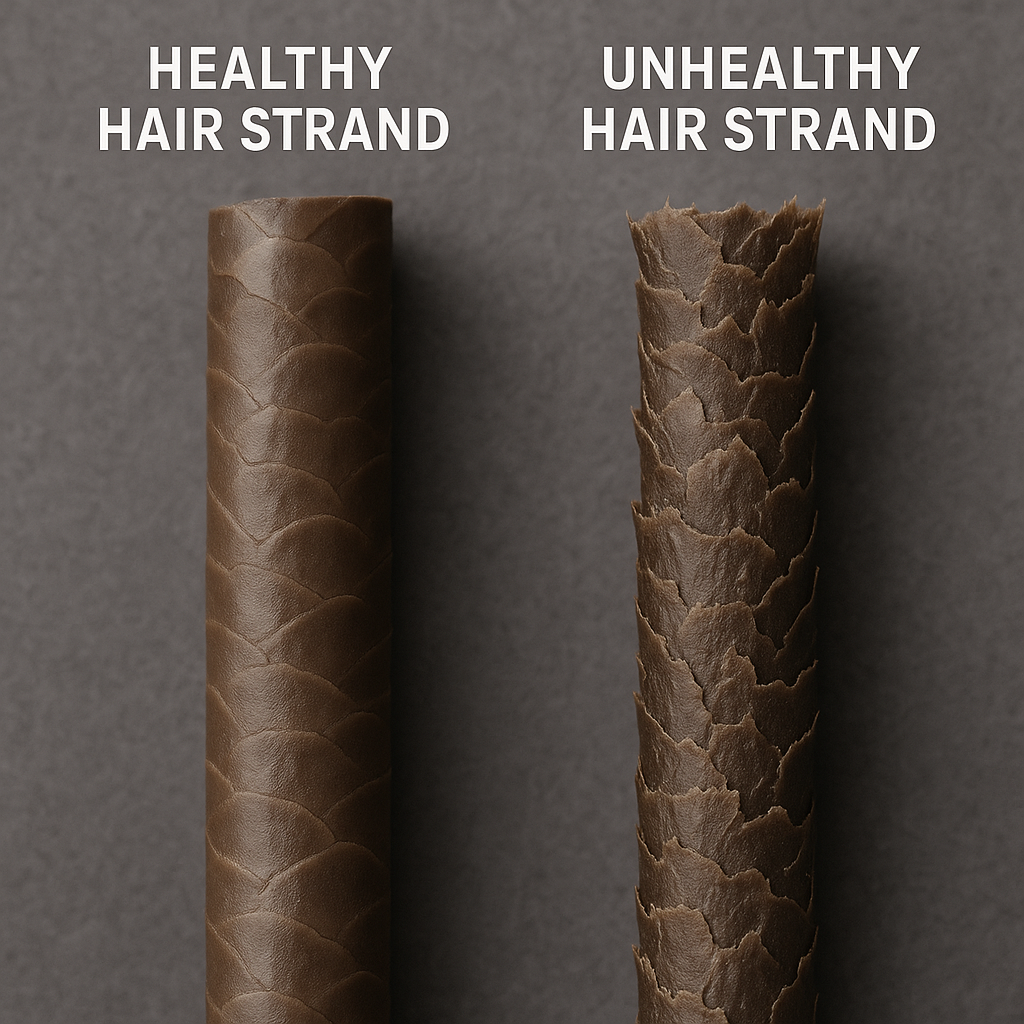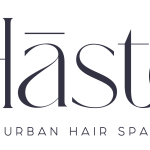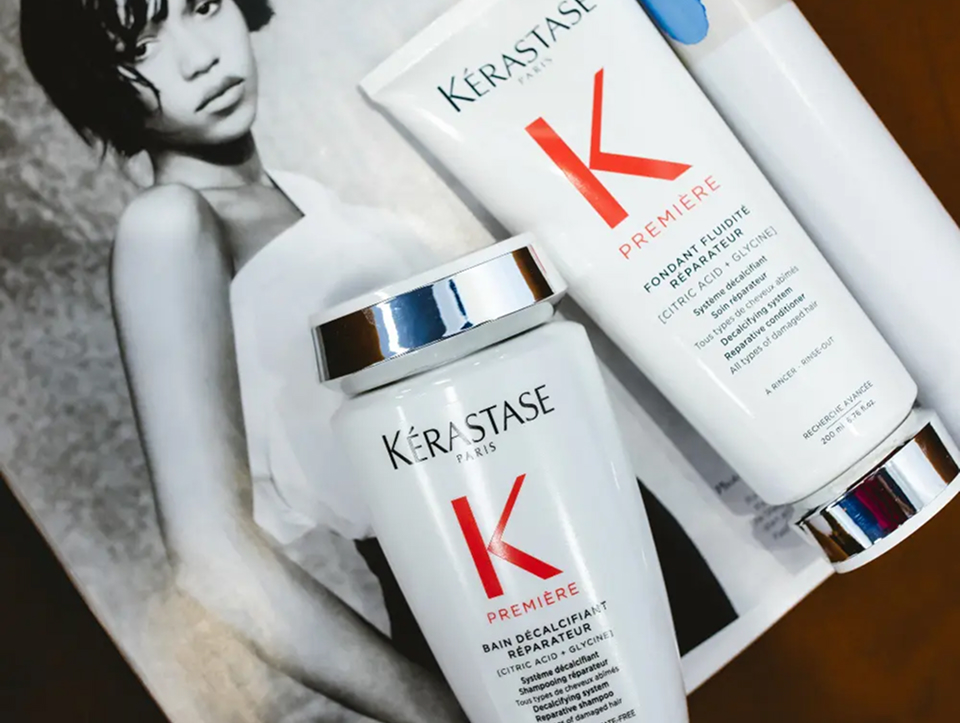Healthy hair needs two essential elements: protein and moisture. Protein is your hair’s builder: it repairs damage, restores strength, and keeps the hair’s structure intact. Moisture is your hair’s softener: it hydrates, improves flexibility, and prevents brittleness.
When your hair has too much protein, it can become stiff and break easily. Too much moisture can make it feel limp, mushy, and weak. Without the right balance, even the best products won’t give lasting results.
Understanding the role of both protein and moisture means you can stop guessing and start building a routine that keeps your hair healthy, shiny, and resilient year-round.
Whether you’re getting a keratin treatment, trying a protein treatment, or want to improve your at-home hair care, this guide will help you find your perfect protein-moisture balance.
Your Hair’s Structure & Why Balance Matters

Your hair is made of three layers:
- Cuticle (outer layer) → lets moisture in and out.
- Cortex (middle) → holds most of the protein (keratin) and determines strength and shape.
- Medulla (core) → not always present in fine hair, but stores some structural information.
Science Check 🔬: Keratin makes up ~90% of the hair shaft, and healthy hydration affects how the fibers bend and move (arxiv.org).
💡 Tip: If your cuticle is damaged or sealed too tightly, it either leaks moisture too quickly or won’t let hydration in at all. Both situations can cause trouble.
Protein and Moisture: When Does Your Hair Need It?

When Your Hair Needs Protein
Protein = Structure & Strength
Protein treatments fill in the gaps in your hair shaft, repairing damage from coloring, heat styling, chemical processing, or UV exposure.
Signs You Need More Protein:
- Hair feels mushy when wet but limp when dry.
- Snaps easily with no “bounce back.”
- Lacks body and looks lifeless.
Causes:
- Frequent coloring or bleaching.
- Heat styling (straighteners, curling irons).
- Sun, chlorine, or saltwater damage.
- Harsh shampoos or styling products.
💡 Tip: If your hair breaks before stretching even a little, it’s likely protein-deficient. If you’re unsure, read our Protein Treatments Guide for safe product choices.
When Your Hair Needs Moisture

Moisture = Elasticity & Softness
Moisture helps your hair bend without breaking. Without it, hair becomes dry, rough, frizzy, and tangles easily.
Signs You Need More Moisture:
- Feels like straw or hay.
- Looks dull and lacks shine.
- Breaks when manipulated.
- Gets static or frizzy in dry air.
Causes:
- Too much protein without enough hydration.
- Dry climates or winter heating.
- Over-washing or harsh shampoos.
- Environmental exposure (wind, UV).
💡 Tip: Think of moisture as the “yoga teacher” for your hair, keeping it flexible and relaxed, so it doesn’t snap under pressure.
👉 Did you know that minimalist hair care is now a trend? Read our article on how you can start a haircare routine with minimal effort.
Two At-Home Hair Tests For Protein & Moisture

The Stretch Test (Elasticity)
- Take a single strand of clean, dry hair.
- Stretch it gently between your fingers.
- Snaps right away → needs moisture.
- Stretches then returns → balanced.
- Stretches too far and stays elongated → needs protein.
The Float Test (Porosity & Moisture Retention)
- Place a few strands in a glass of water:
- Floats → low porosity (moisture struggles to enter).
- Sinks → high porosity (loses moisture quickly).
💡 Tip: Porosity guides how you moisturize. Low porosity? Lightweight hydrators. High porosity? Heavier creams or oils.
Lack of moisture results when the outer layers are too tightly shut or too widely open. The vents along the cuticle need to open and close quickly. If not, your hair can change in different ways.
Hence, your hair will have a rough texture and look dull and lifeless. The hair also tends to get easily tangled and frizzy.
How to Balance Protein & Moisture

Weekly Moisture Treatments
- Deep condition or use a leave-in with aloe vera, glycerin, or hyaluronic acid.
- Avoid heavy oils if you have low porosity hair.
Protein Every 3–6 Weeks
- Use hydrolyzed keratin, silk, or wheat protein.
- For low porosity hair, choose smaller proteins to penetrate the cuticle.
Lock It In
- Seal with coconut oil to reduce protein loss (Verywell Health).
💡 Tip: Always moisturize after protein treatments to prevent stiffness, and while you’re here, learn more about the differences between keratin and protein treatments. Additionally, check out the Brazilian Botox aftercare here.
Protein and Moisture Ingredient Cheat Sheet
| Protein Ingredients | Moisture Ingredients |
|---|---|
| Keratin – Repairs and strengthens hair structure. | Aloe Vera – 98% water; instantly hydrates hair. |
| Hydrolyzed Silk Protein – Smooths the cuticle, adds shine. | Glycerin – Draws moisture into the hair shaft. |
| Amino Acids – Rebuild damaged protein bonds inside hair. | Honey – Natural humectant that retains moisture. |
| Hydrolyzed Wheat Protein – Fills weak spots, improves elasticity. | Hyaluronic Acid – Locks in hydration for lasting softness. |
| Collagen – Improves elasticity and adds a protective barrier. | Coconut Oil – Seals in moisture and protects protein. |
💡 Tip:
- Use warm peach tones for the protein side to give a “strength/energy” feel.
- Use cool blue tones for the moisture side to suggest “hydration/refreshment.”
🌿 Learn more about hair care goals for 2026
Quick Hair Needs Table

| What Your Hair Did | Your Hair Needs |
|---|
| Snapped instantly | Moisture |
| Stretched & bounced back | Balanced |
| Stretched & stayed stretched | Protein |
| Floated in water | Lightweight hydration |
| Sank in water | Heavier moisture |
💡 Tip: Make sure to check out the Kerastase range to provide you with a perfect balance of protein and moisture for your hair.
🎁 Explore these holiday hair tips to look your best at any party
Protein and Moisture – Your Hair’s Perfect Partnership
Striking the right balance between protein and moisture isn’t just about making your hair look good; it’s about keeping it strong, flexible, and healthy from the inside out. Protein reinforces your hair’s structure, while moisture keeps it soft and resilient.
When either one is out of balance, you’ll see the signs in your texture, elasticity, and shine. By learning to spot symptoms, performing simple at-home tests, and choosing the right treatments, you can transform how your hair feels and behaves.
Consistency is key. Think of your hair care routine as a cycle, not a one-time fix. If you’re ever in doubt about what your hair needs, let the experts take the guesswork out.
Ready to discover precisely what your strands are craving? Book your personalized Hair Consultation with Haste Hair today. Our stylists will assess your hair’s protein and moisture balance, recommend tailored treatments, and help you achieve that healthy, radiant hair you’ve been dreaming of.
FAQ
How do you know my hair needs protein or moisture?
You can test your hair by stretching a dry strand out. If it snaps easily or feels dry, it needs to be moistened. It needs protein to bounce back into shape, but it feels mushy when wet.
Can I have too much protein in my hair?
Yes, it’s called “protein overload,” It makes hair stiff and brittle
Can I need both protein and moisture at the same time?
Yes. Most people benefit from both, although the benefits may not be in equal amounts all the time.
Does diet affect protein and moisture balance?
Yes, hair health starts inside. Include lean proteins, healthy fats, and hydrate well daily.








